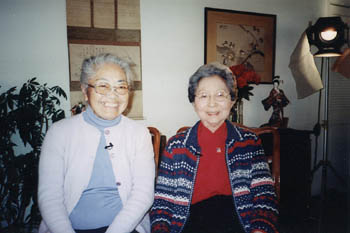![[Metroactive Movies]](/movies/gifs/movies468.gif)
[ Movies Index | Show Times | Silicon Valley | Metroactive Home | Archives ]

Taped Crusaders: To Kitako Izumazki and Helen Nitta Mito of Watsonville, "camp" doesn't mean canoeing and open fires. Civil Wrongs 'Return to the Valley' shows the mettle of local Japanese-Americans in post-internment and pre-civil rights America By Todd Inoue THE Japanese-American experience in the valley has long been based on oral tradition. When schools did include it in the curriculum, it was usually confined to a footnote or a sentence. If you wanted the real deal, you got it straight from your folks--if they were willing to talk about it at all. Re-examining the Japanese-American internment of 1942-1945 produces different reactions in different families. Some are open to talk about it, others can't approach the feelings of repression and shame. In June, KTEH and Christina Lim unveiled Return to the Valley, a documentary and educational project that explored the lives of Santa Clara Valley residents before and after FDR signed executive order 9066 and removed 120,000 Japanese-Americans from the West Coast and forced them to live in internment camps. Lim and her crew spent two years gathering the stories. As Japanese immigrated to the valley at the turn of the century, many settled in the farm communities of Santa Clara, Monterey, Pajaro Valley, Salinas and the Central Coast. Many toiled on the farms or along the coast working the fishing boats. At one point, 90 percent of strawberries were cultivated by Japanese-Americans. Things were moving along until 1942, when Japan bombed Pearl Harbor. The documentary reveals the effect that internment had on the "Issei," or the first generation. As newcomers to America, many of the Issei fought daily battles against racism and prejudice to get their share of the pie before internment took it away. The experience left many Issei old, tired and broken, leaving the second generation (Nisei) to rebuild. While others were deeply broken by the experience, David Tatsuno's "make the best of it" attitude kept him sane. "I remember sitting down in April 1942 and writing my thoughts," he says in the intro. "One of the thoughts was, 'No matter what happens, make the best of it. In triumph or disaster, treat the two imposters the same.' That made the difference." Other locals give touching remembrances and testimonials to the enduring spirit. Two of the last remaining Issei, Suenyo Inada and Phillip Kobashi, remember the way life changed for them in 1942. Local activist Jimi Yamaichi recounts trying to find a construction job and how his determination lead to his breaking the construction color barrier. Mike Honda decides between helping the family on the farm and playing high school football. Lawson and Mineko Sakai talk about life for Japanese-Americans postwar and pre-civil rights. At the end, there is a hopeful denouement: that the mistakes of the past won't be repeated. Hosted by Ken Kashiwahara, Return to the Valley is the first episode of a new cultural and historical anthology series Voices of the Valley. At the June community screening at Camera 3, many of the interviewees and their families were in attendance. After the show, everyone enjoyed Aki's guava cake and coffee, the old-timers caught up and reminisced while the kids chased each other. Life, as unpredictable as it is, went on.
Return to the Valley airs Tuesday (Nov. 25) on KTEH, Channel 54, at 8pm. For more information, go to www.kteh.org.
Send a letter to the editor about this story to letters@metronews.com. [ Silicon Valley | Metroactive Home | Archives ]
|
From the November 20-26, 2003 issue of Metro, Silicon Valley's Weekly Newspaper.
Copyright © Metro Publishing Inc. Metroactive is affiliated with the Boulevards Network.
For more information about the San Jose/Silicon Valley area, visit sanjose.com.